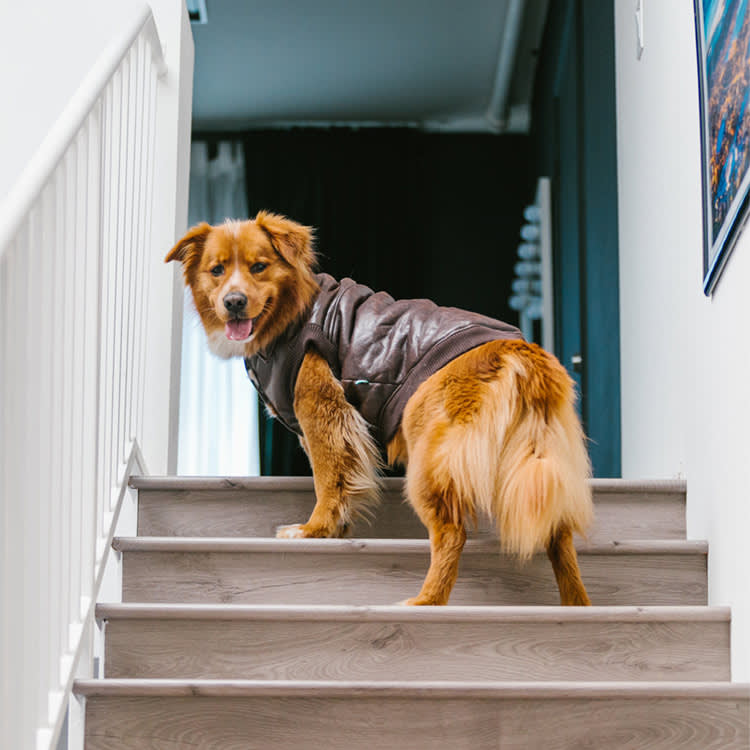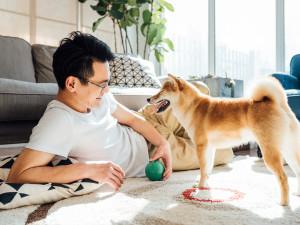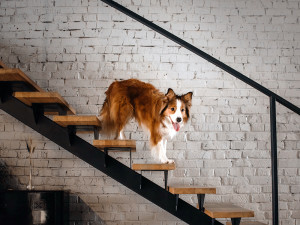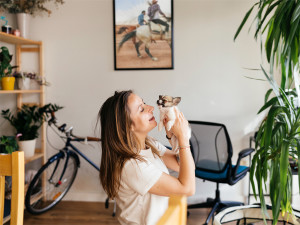Teach Your Dog to Climb Stairs
Tips on how to train your dog to go down stairs.
Try crawling down a flight of stairs on all fours, and the experience may give you instant insight into why so many dogs hesitate about going down. Having your head aimed down at such a steep angle takes some getting used to. There are dogs who struggle to go up and down the stairs, but it is far more common for dogs or puppies who lack experience with them to be especially resistant to going down.
Luckily, most dogs respond well if they are taught how to negotiate stairs in an (appropriately named) step-by-step process. The key is to teach dogs how to go down one or two steps at a time, avoiding having those steps be the ones at the top of a full flight of stairs, where the view seems a bit scary to most dogs.
Train Your Dog Down Stairs
1. Start with a single step.
Ideally, begin by working with a dog in a place that has just a single step, if one is available to you. Typically, dogs are comfortable taking a single step down onto a long stretch of level ground. Using a smelly delicious food treat, you can lure a dog up the step, and immediately lure them back down. Do this several times in multiple short sessions until the dog is going up and down the step without any hesitation.
2. Graduate to a few steps.
The next phase of training involves having the dog go down a few steps at a time. If you have a place with only 2-4 steps, that is ideal, but if not, you can use the bottom few steps of a flight of stairs. It’s easier with small dogs who you can lift up to the step and then lure down, but with bigger dogs, you can lure up and down if the dog is able to turn around on the step.
How much do you spend on your pet per year?
3. Keep expanding the steps they take.
Once the dog is comfortable with several stairs (depending on your options, this may be 3 to 7 stairs at one time), expand the number of steps until the dog can go down an entire flight of stairs on his own.
As with any training, don’t force the dog. Work slowly within the dog’s physical and emotional comfort zone to avoid falls. Be patient, only progressing to a harder task when the dog is clearly comfortable with the current one.
Tips For Small Dogs
If you have a small dog, you make need to make some adjustments. In step one, you can lift them up and then lure them down the step, enticing them to step down by having them follow the treat. I prefer to lure both up and down, so the dog feels more in control of the situation.
Tips For Big Dogs
If the dog is too big to do point two comfortably and safely, then either try to find a place with just a few steps, or work at the top of the steps, but hold a blanket or pillow to block the view of the full flight of stairs and lure down two to four steps at a time and then move the visual blocker and do the next few steps.
Sometimes just standing below the dog on the steps is enough to block the view or reassure the dog and give them the confidence to descend one step at a time. If you have stairs with a landing in the middle, consider yourself lucky because you can do half as many steps and get the dog down on solid flat ground. That makes for a nice intermediate stage.








